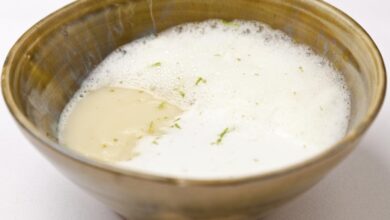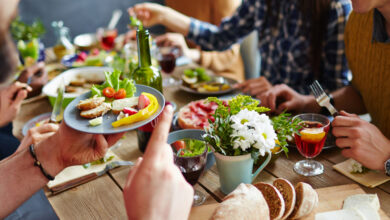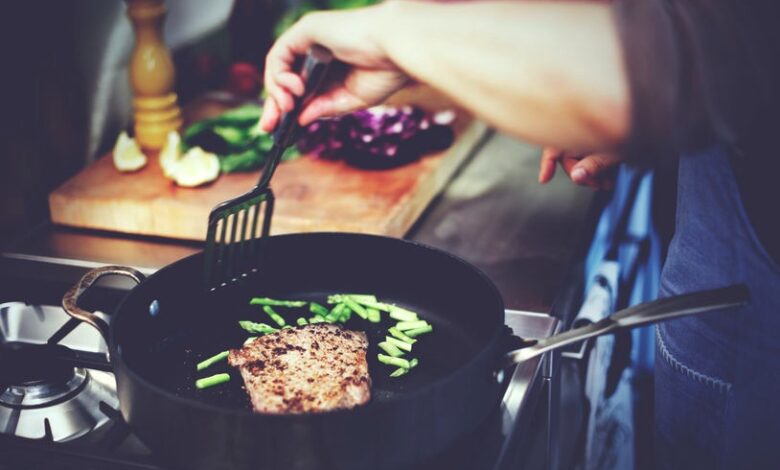
How to Be a Better Cook A Comprehensive Guide
How to be a better cook? This isn’t just about following recipes; it’s about understanding the fundamentals of cooking, from mastering techniques to selecting the perfect ingredients. We’ll explore essential cooking methods, ingredient preparation, flavor combinations, and more. Get ready to elevate your culinary skills and impress your taste buds (and your guests!).
This guide will take you on a journey through the world of cooking, providing you with the knowledge and tools to become a confident and creative chef. From basic techniques to advanced culinary artistry, we’ll cover everything you need to know to transform your kitchen into a culinary haven.
Understanding Fundamental Cooking Techniques
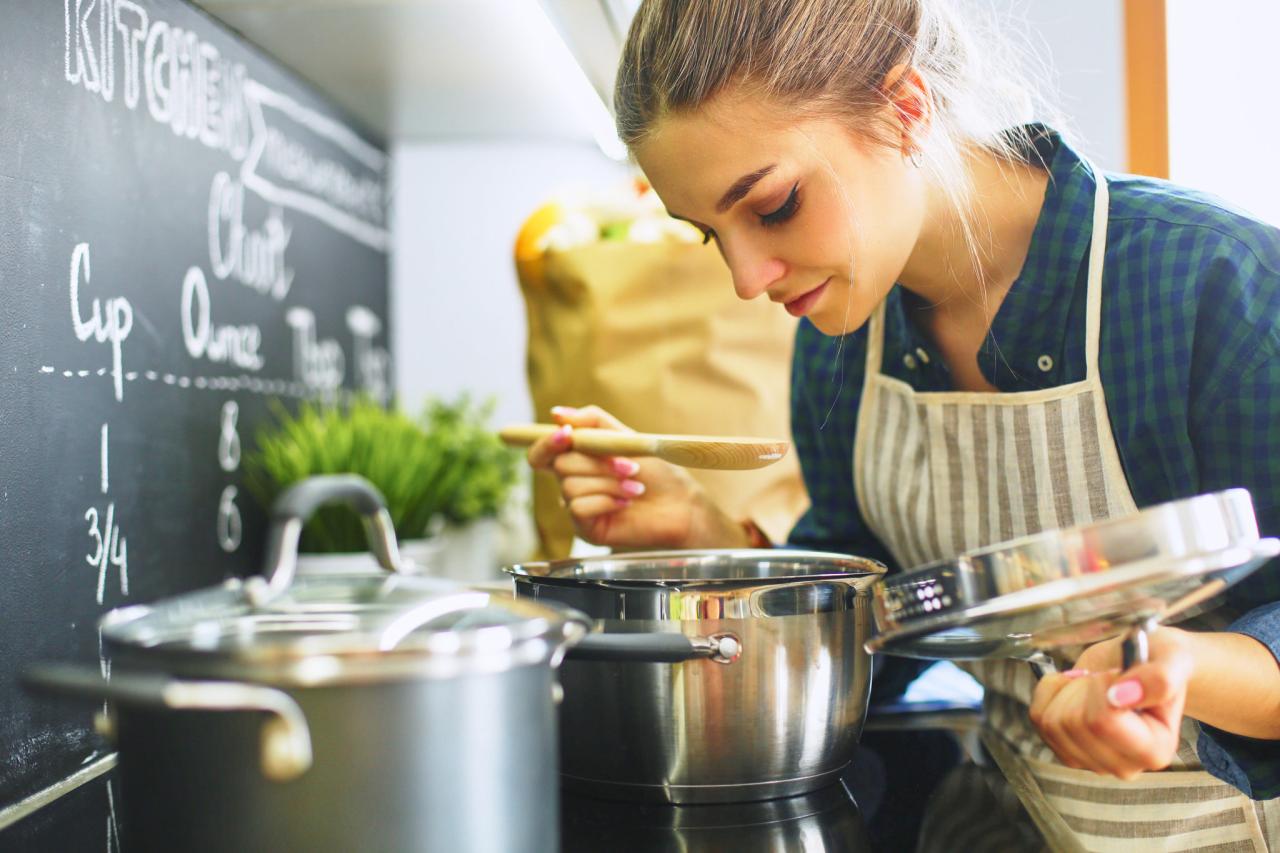
Mastering fundamental cooking techniques is the cornerstone of becoming a proficient cook. It’s about understanding how heat interacts with different ingredients and how various cooking methods impact flavor and texture. From the gentle simmer to the intense sear, each technique offers unique possibilities for transforming raw ingredients into culinary masterpieces.
Essential Cooking Methods
Different cooking methods are employed depending on the desired outcome and the nature of the ingredients. Understanding these methods allows you to craft dishes with precise control over the final product. Each method relies on varying degrees of heat and time, affecting the moisture content, texture, and flavor of food.
Sautéing
Sautéing involves cooking food in a small amount of hot oil or fat over medium-high heat. The rapid heat transfer results in a quick and even browning, enhancing the flavor and creating a desirable texture. Proper sautéing requires maintaining a high heat and constant stirring to prevent burning and ensure even cooking. A well-seasoned pan is crucial for optimal results.
For example, sautéing vegetables like onions, garlic, and bell peppers before adding other ingredients to a dish can elevate the flavor profile significantly.
Roasting
Roasting is a dry-heat cooking method that uses an oven or other enclosed heating source. The circulating hot air cooks food evenly, resulting in a crispy exterior and a tender interior. Roasting is particularly well-suited for meats, poultry, vegetables, and even certain types of desserts. Temperature control is critical in roasting to achieve the desired doneness without overcooking or undercooking.
For example, a roast chicken cooked in a hot oven will achieve a golden-brown skin while the meat remains juicy.
Grilling
Grilling involves cooking food over an open flame or under a direct heat source. The high heat produces a smoky flavor and a characteristic grill mark. Grilling is ideal for meats, vegetables, and even seafood. Maintaining a consistent temperature is essential for even cooking. For example, grilling steak allows for a delicious sear that enhances the natural flavor of the meat.
Boiling
Boiling involves cooking food in liquid at a rolling boil. This method is commonly used for cooking pasta, vegetables, and other foods that require a shorter cooking time. The rapid heat transfer cooks the food quickly and evenly. The liquid itself plays a role in the final flavor and texture. For example, boiling potatoes in salted water enhances their flavor.
Cookware Selection and Temperature Control
Proper cookware selection significantly impacts the outcome of your dishes. A well-chosen pan or pot can distribute heat evenly and prevent sticking. For sautéing, a heavy-bottomed pan is ideal. For roasting, a roasting pan with a rack is beneficial for even browning and to allow air circulation. Temperature control is essential for all cooking methods.
Use a thermometer to ensure precise temperature readings. Adjusting heat as needed is critical to avoid burning or undercooking.
Comparison of Cooking Methods
| Method | Pros | Cons | Suitable Foods |
|---|---|---|---|
| Sautéing | Quick cooking, even browning, good for vegetables and proteins, develops flavor | Requires careful attention to heat, can easily burn food if not managed properly | Vegetables, meats, seafood, tofu |
| Roasting | Even cooking, crispy exterior, tender interior, good for larger cuts of meat, vegetables | Can be time-consuming, requires careful monitoring of temperature | Meats, poultry, vegetables, whole fruits |
| Grilling | Smoky flavor, grill marks, good for outdoor cooking, fast cooking | Requires outdoor space, can be difficult to control temperature, risk of burning | Meats, poultry, vegetables, fish |
| Boiling | Simple, quick cooking, good for pasta, vegetables, and other foods that need a shorter cooking time | Can make food mushy if overcooked, can lose nutrients | Pasta, grains, vegetables, legumes |
Ingredient Selection and Preparation
The heart of any delicious meal lies not just in the techniques, but in the quality of the ingredients. Choosing fresh, high-quality produce and meats is crucial to achieving a satisfying culinary experience. Proper preparation, from chopping to dicing, further enhances the flavor and texture of the final dish. Understanding the nuances of ingredient selection and preparation is an essential step towards becoming a more confident and capable cook.Selecting fresh, high-quality ingredients is paramount.
Mastering the art of cooking takes more than just following recipes; it’s about understanding ingredients and experimenting with flavors. Learning about the history of culinary practices, or even tragic events like the story of lovers in Auschwitz, Keren Blankfeld, and the cold crematorium of József Debreczeni, can offer surprising insights into how cultures approach food. Ultimately, the key to becoming a better cook is embracing the journey of discovery, from ingredient sourcing to personal expression, whether in a bustling kitchen or reflecting on history.
The flavor, texture, and nutritional value of your dish are directly impacted by the ingredients you choose. Look for produce with vibrant colors, firm textures, and a pleasant aroma. Meats should exhibit a rich color and a pleasing scent, free from any unusual odors or discoloration. Avoid ingredients that show signs of bruising, wilting, or spoilage.
Buying in season will often provide the best quality and flavor.
Ingredient Preparation Techniques
Proper preparation of ingredients is as important as the selection itself. Different cuts achieve different results in terms of cooking time and texture. Techniques like chopping, dicing, mincing, and julienning are fundamental to many recipes. These techniques not only make the ingredients aesthetically pleasing but also facilitate even cooking and optimal flavor release.
Impact of Ingredient Quality
The quality of ingredients significantly impacts the final dish. Fresh, high-quality ingredients contribute to a more vibrant flavor profile and a more appealing texture. For example, using overripe tomatoes in a sauce will result in a mushy and less flavorful dish. Conversely, using crisp, ripe tomatoes will yield a more complex and nuanced sauce. The quality of your ingredients will always be reflected in the final product.
Common Kitchen Tools for Ingredient Preparation
A well-equipped kitchen is essential for efficient and precise ingredient preparation. Some essential tools include:
- Chef’s knives (various sizes): A chef’s knife is a versatile tool used for a wide range of tasks, from chopping to mincing. Different sizes cater to different needs.
- Paring knives: These smaller knives are ideal for precise tasks like peeling fruits and vegetables.
- Vegetable peeler: This tool efficiently removes the outer layer of vegetables.
- Cutting boards: Using separate cutting boards for produce and meat prevents cross-contamination.
- Measuring cups and spoons: Accurate measurements are critical for achieving the desired consistency in recipes.
- Mixing bowls: Various sizes and materials are available, each suited to different cooking needs.
Different Types of Cuts
The type of cut significantly affects how ingredients cook and contribute to the overall dish. Different cuts for vegetables and meats lead to distinct cooking times and textures. For example, thinly sliced vegetables like julienne will cook faster than larger chunks. The chosen cut should be tailored to the specific recipe and the desired final product.
Table of Various Cuts
| Ingredient | Cut | Description | Image Description |
|---|---|---|---|
| Carrot | Julienne | Thin, matchstick-like strips | Imagine a carrot sliced into long, thin strips, like matchsticks. The strips should be relatively uniform in thickness. |
| Potato | Dice | Small, cube-shaped pieces | Visualize small, evenly sized cubes cut from the potato. |
| Onion | Minced | Very small, finely chopped pieces | Imagine tiny, almost invisible pieces of onion. |
| Beef | Cubed | Large or small cubes | Visualize chunks of beef cut into uniform cubes. The size of the cubes can be adjusted based on the recipe. |
| Chicken Breast | Sliced | Thin, even slices | Imagine thin, uniform slices cut from the chicken breast. |
Mastering Flavor Combinations
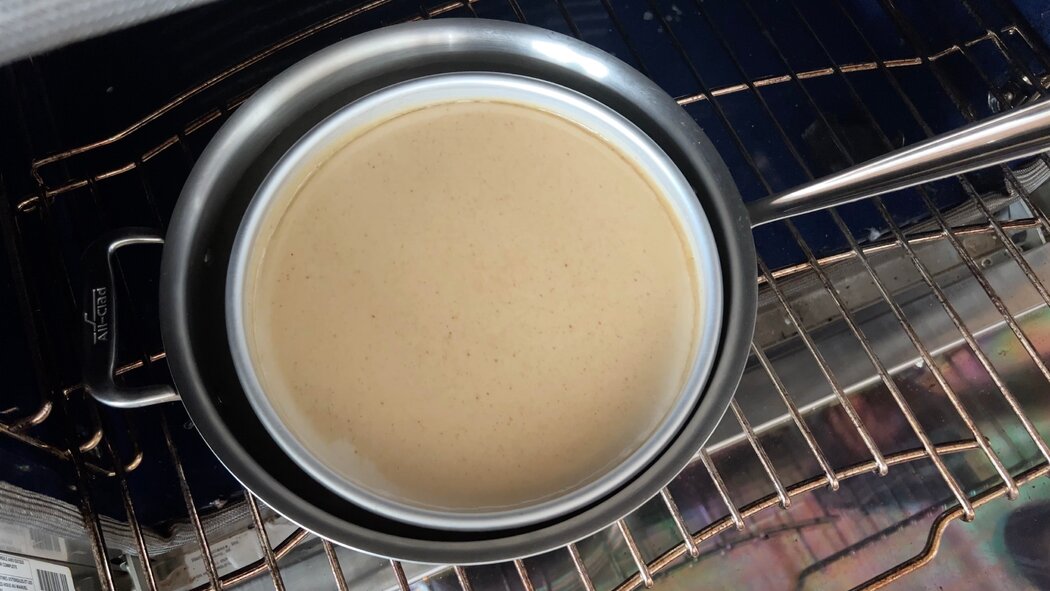
Unlocking the secrets of delicious food often hinges on understanding how flavors interact. Beyond simply knowing ingredients, the art of cooking involves crafting harmonious flavor profiles that tantalize the taste buds. This exploration delves into the world of flavor combinations, examining how to balance tastes, and the critical role of herbs and spices in enhancing culinary creations.Flavor combinations are not arbitrary; they are based on fundamental principles of taste harmony.
By understanding these principles, you can elevate your cooking from merely edible to truly exceptional. This section will guide you through identifying common flavor profiles, balancing them in a dish, and the crucial role herbs and spices play in enhancing the experience.
Common Flavor Profiles
Flavor profiles are groups of tastes that work well together. Identifying these profiles allows cooks to build dishes with a predetermined character. Understanding the basic profiles is the foundation for creating successful flavor combinations.
Balancing Flavors
Achieving balance in a dish is paramount. It’s not just about the presence of various tastes but also their relative intensities. A dish with too much salt, for instance, can overpower other flavors. Conversely, a dish lacking sufficient acidity can leave the palate feeling flat. Balancing these components is a key skill.
Herbs and Spices: Flavor Enhancers
Herbs and spices are not just decorative additions; they are potent flavor enhancers. Their aromatic compounds interact with other ingredients to create depth and complexity. The right herb or spice can transform a simple dish into a culinary masterpiece. For example, a pinch of cinnamon in a savory dish can add warmth and intrigue.
Examples of Successful Flavor Combinations
Numerous successful flavor combinations exist. One powerful example is the combination of sweet and savory, frequently seen in dishes featuring caramelized onions, sweet potatoes, or roasted vegetables paired with savory meats or cheeses. Another example is the pairing of acidic and spicy flavors in dishes like Thai curries or Korean bibimbap.
Flavor Pairing Table
| Flavor Profile | Ingredients | Examples |
|---|---|---|
| Sweet and Spicy | Sugar, chili peppers, ginger, honey, citrus | Sweet chili sauce, mango salsa with jalapeños, spicy barbecue ribs, pumpkin curry |
| Savory and Umami | Soy sauce, mushrooms, miso paste, parmesan cheese, anchovies | Beef stroganoff, mushroom risotto, Japanese ramen, marinara sauce |
| Acidic and Fresh | Lemon juice, lime juice, vinegar, tomatoes, citrus fruits | Citrus salad, vinaigrette, salsa, ceviche, gazpacho |
| Salty and Smoky | Sea salt, smoked paprika, bacon, smoked meats, roasted vegetables | Smoked salmon with dill, pulled pork, roasted vegetables with balsamic glaze, barbecue sauce |
| Earthy and Nutty | Mushrooms, truffles, nuts, herbs like rosemary, thyme | Mushroom pasta, roasted butternut squash with pecans, wild rice pilaf, mushroom soup |
Recipe Creation and Modification
From simple tweaks to completely new creations, adapting and crafting recipes is a crucial part of culinary exploration. It’s about taking existing recipes as a springboard and personalizing them to suit your tastes and dietary needs. This journey of recipe modification and creation involves a deeper understanding of ingredients, flavors, and cooking methods. It’s a dynamic process that allows you to truly express your culinary creativity.
Adapting Existing Recipes
Modifying existing recipes is a great way to experiment and explore new flavors. Start by understanding the fundamental structure of the recipe. Identify the key ingredients and their roles in the dish. This knowledge allows you to make informed decisions about substitutions and adjustments. For instance, if a recipe calls for butter, you can substitute it with olive oil or a vegan butter alternative.
Gradually, introduce adjustments to your preference; start with minor changes and build up to larger ones. Experimentation is key; don’t be afraid to try different combinations of spices or herbs. A slight adjustment in seasoning can completely transform a dish.
Modifying Recipes for Dietary Needs
Adapting recipes for dietary restrictions is essential for inclusivity and ensuring everyone can enjoy delicious meals. Vegetarian, vegan, and gluten-free diets require specific substitutions and adjustments. For a vegetarian recipe, replace meat with plant-based proteins like lentils, tofu, or beans. For vegan dishes, ensure all ingredients are free from animal products. Gluten-free recipes require the substitution of wheat-based ingredients with gluten-free alternatives like rice flour, almond flour, or tapioca starch.
Carefully read labels to confirm the absence of allergens. Understanding ingredient labels is crucial for safe and successful adaptation.
Understanding Recipe Structure
Understanding a recipe’s structure is essential for both modification and creation. It’s not just a list of ingredients and steps. A well-structured recipe offers insights into the cooking process, ingredient relationships, and desired outcomes. A good recipe will provide specific measurements for ingredients, detailed instructions for each step, and a clear indication of cooking times and temperatures.
This structured approach ensures consistency and allows for a greater understanding of how each ingredient contributes to the final dish. Detailed instructions help maintain consistency in taste and texture.
Creating a New Recipe from Scratch
Crafting a new recipe is a journey of experimentation and inspiration. It’s about combining flavors, textures, and techniques to create something unique and delicious. Begin with an idea, a flavor profile, or a desired outcome. Explore different combinations of ingredients, focusing on their flavor profiles and textures. Experimentation is vital to develop your own style and discover new culinary possibilities.
Start with a basic framework of ingredients and gradually build upon it, layering flavors and techniques to enhance the dish. This process of iteration is crucial in the recipe development process.
Steps in Creating a New Recipe, How to be a better cook
| Step | Description | Tools/Ingredients |
|---|---|---|
| 1. Brainstorming | Generate ideas, considering desired flavors, textures, and dietary needs. Research similar dishes and note inspiration. Focus on the overall concept of the dish. | Notebook, pen, internet access for research, cooking inspiration (recipes, cookbooks, etc.) |
| 2. Ingredient Selection | Choose ingredients based on the desired flavors and textures. Consider their availability, cost, and nutritional value. Note any potential substitutions or adaptations for dietary needs. | Shopping list, ingredient knowledge, recipe references |
| 3. Recipe Development | Artikel the cooking process, including cooking methods, timing, and temperature. Develop the flavor profile by considering seasonings, herbs, and spices. | Cooking utensils, measuring tools, recipe references |
| 4. Testing and Refinement | Prepare and cook multiple batches of the recipe, making adjustments as needed to the flavor, texture, and overall outcome. Gather feedback from others. | Kitchen equipment, feedback from others, willingness to adjust |
| 5. Documentation | Document the recipe with clear instructions, ingredient measurements, and cooking times. Capture essential details for reproducibility. | Recipe format, documentation tools (digital or physical) |
Cooking Techniques for Specific Foods
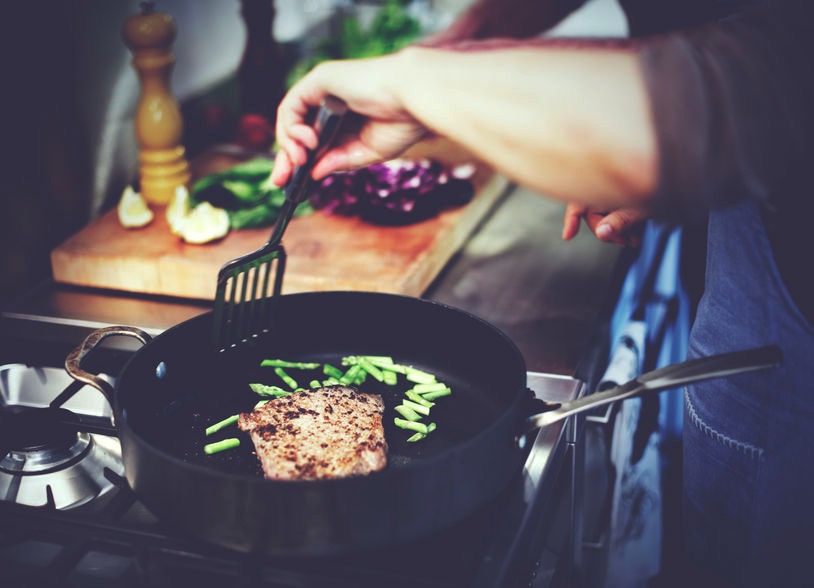
Mastering cooking techniques for different food types is crucial for achieving delicious and consistent results. Understanding the nuances of each ingredient, from tenderizing tough cuts of meat to preserving the delicate flavor of seafood, elevates your cooking from competent to exceptional. This section delves into the specific techniques for various foods, highlighting the key differences and providing examples of dishes that showcase these methods.
Meat Cooking Techniques
Different cuts of meat require different approaches to cooking. Proper technique ensures tenderness, flavor, and prevents dryness or toughness. Selecting the appropriate cooking method is critical for optimal results.
- Poultry: Poultry, such as chicken and turkey, often benefits from methods like roasting, pan-frying, or grilling. Roasting allows for even heat distribution and a crispy skin, while pan-frying delivers a rich, flavorful crust. Grilling provides a smoky char and a quick cooking time. Examples include roasted chicken with herbs and lemon, pan-fried chicken breasts with garlic butter, and grilled turkey kebabs.
Proper seasoning and brining techniques enhance the natural flavors of poultry.
- Beef: Beef, with its varying cuts, demands a tailored approach. Steaks, for instance, are best seared and then finished in a low-temperature oven or on the grill. Roasting is suitable for larger cuts like roasts, while braising tenderizes tough cuts. Examples include a pan-seared ribeye steak, a slow-cooked beef short rib stew, and a roasted beef tenderloin.
- Pork: Pork, with its rich flavor, can be cooked in various ways. Pan-frying creates a flavorful crust, while roasting produces a juicy and tender result. Grilling and braising are also popular methods. Examples include pan-fried pork chops, roasted pork loin, and braised pork belly.
Vegetable and Fruit Cooking Techniques
The diverse world of vegetables and fruits calls for a range of cooking methods. Each technique preserves different textures and flavors, influencing the final dish.
- Vegetables: Vegetables, like broccoli, carrots, and potatoes, can be boiled, steamed, roasted, or sautéed. Boiling is a simple method for tenderizing vegetables, while steaming preserves nutrients. Roasting enhances the natural sweetness of vegetables. Sautéing delivers a quick and flavorful result. Examples include roasted asparagus with garlic, steamed broccoli with soy sauce, and sautéed spinach with mushrooms.
- Fruits: Fruits, such as berries, apples, and bananas, are often cooked by baking, roasting, or grilling. Baking and roasting are good for maintaining fruit structure, while grilling can create a smoky flavor. Examples include baked apples with cinnamon, roasted peaches with honey, and grilled pineapple with balsamic glaze.
Seafood Cooking Techniques
Seafood requires delicate handling to maintain its delicate flavor and texture. Proper cooking techniques prevent overcooking and maintain moisture.
- Fish: Fish, like salmon, cod, and tuna, can be pan-fried, baked, grilled, or poached. Pan-frying creates a flavorful crust, while baking or grilling maintains moisture. Poaching is ideal for delicate fish. Examples include pan-fried salmon with dill, baked cod with lemon, and grilled tuna steak.
- Shellfish: Shellfish, such as shrimp, clams, and oysters, are best cooked quickly over high heat. Stir-frying, grilling, or steaming are common methods. Examples include stir-fried shrimp with garlic, grilled mussels with white wine, and steamed oysters with butter.
Comparing Fish Cooking Methods
Different fish species react differently to various cooking methods. Understanding these differences helps achieve optimal results.
| Fish Type | Ideal Cooking Method | Reasoning |
|---|---|---|
| Salmon | Baking or grilling | High fat content holds up well to dry heat. |
| Cod | Baking or poaching | Delicate flesh is best preserved with moist heat. |
| Tuna | Searing or grilling | Provides a firm texture and intense flavor. |
Maintaining a Clean and Organized Kitchen: How To Be A Better Cook
A clean and organized kitchen is more than just aesthetically pleasing; it’s crucial for safe and efficient cooking. A well-maintained space minimizes cross-contamination, prevents accidents, and streamlines the entire cooking process, from ingredient prep to dishwashing. This is vital for both professional chefs and home cooks.A clean kitchen environment promotes a positive cooking experience. The reduced clutter and easy access to tools and ingredients contribute to a smoother workflow, allowing you to focus on the creative aspects of cooking rather than the practical challenges of a disorganized space.
Importance of Kitchen Cleanliness
A clean kitchen is paramount for food safety. Proper hygiene practices prevent the spread of bacteria and contamination, ensuring that your food is safe to eat. Regular cleaning and sanitation of surfaces, utensils, and equipment minimize the risk of foodborne illnesses. A clean kitchen also helps prevent unpleasant odors and creates a more inviting atmosphere for cooking and entertaining.
Cleaning and Maintaining Kitchen Tools and Equipment
Proper cleaning and maintenance of kitchen tools and equipment prolong their lifespan and ensure their optimal performance. Different materials require different cleaning methods. For instance, stainless steel requires specific cleaning solutions to prevent scratches. Wooden utensils need gentle cleaning to avoid warping. Following manufacturer instructions for each item is essential to avoid damage and maintain the quality of the tools.
- Cleaning Stainless Steel: Use a mild dish soap and a soft sponge or cloth. Avoid abrasive cleaners that can scratch the surface. Rinse thoroughly and dry immediately to prevent water spots.
- Cleaning Non-Stick Cookware: Use warm, soapy water and a non-abrasive sponge or cloth. For stubborn food residue, soak the cookware in warm soapy water for a short period. Avoid harsh scrubbing, which can damage the non-stick coating.
- Cleaning Knives: Clean knives immediately after use. Use a brush to remove food particles. Rinse thoroughly and dry completely. Store knives in a dedicated knife block or holder to prevent accidental cuts.
Storing Ingredients Effectively
Effective storage of ingredients ensures their freshness and prevents spoilage. Proper storage also saves space and makes it easy to locate ingredients when needed. Understanding the specific storage requirements for each type of ingredient is key to maintaining freshness.
- Produce Storage: Store fruits and vegetables in appropriate containers or in the refrigerator, according to their individual needs. For example, leafy greens need to be kept in a sealed container to avoid moisture loss.
- Dry Goods Storage: Store dry goods in airtight containers to prevent moisture absorption and insect infestation. Label containers with the contents and date for easy identification.
- Refrigerated Storage: Store perishable items like meat, dairy, and eggs in designated areas within the refrigerator. Ensure proper temperature control for food safety.
Effective Kitchen Organization
A well-organized kitchen enhances workflow and efficiency. It also saves time and prevents unnecessary stress while cooking. Utilizing storage solutions like drawers, shelves, and cabinets strategically can optimize space and reduce clutter.
- Drawer Organization: Use dividers and containers to organize utensils and small appliances within drawers. This prevents items from getting lost and makes them easy to access.
- Countertop Organization: Keep countertops clear of unnecessary items. Use organizers and trays to store frequently used ingredients and tools.
- Pantry Organization: Use clear containers and labels to organize dry goods and spices in the pantry. This makes it easy to locate items and ensures that you can see how much is left.
Troubleshooting Common Cooking Mistakes
Cooking, like any art form, has its share of challenges. Even experienced chefs occasionally encounter setbacks. Understanding the reasons behind common cooking mistakes is crucial for improvement. This section delves into the pitfalls of the kitchen, offering solutions to overcome them and elevate your culinary creations.
Identifying Common Cooking Mistakes
Common cooking errors frequently stem from a lack of understanding of the science behind cooking, misjudgments of ingredient behavior, or inadequate technique. Overcooking, undercooking, uneven browning, and inconsistent textures are among the most prevalent issues. Recognizing these problems is the first step towards fixing them.
Reasons Behind Cooking Mistakes
Various factors contribute to cooking mishaps. Improper temperature control, inadequate ingredient preparation, inaccurate timing, and variations in equipment performance can all lead to disappointing results. For instance, using a pan that’s too small for the recipe can result in uneven browning. Incorrect measurements or substituting ingredients without understanding their properties can also lead to significant flavor or texture deviations.
Preventing Cooking Mistakes
Careful attention to detail and a grasp of fundamental cooking principles are essential for preventing mistakes. Employing precise measurements, using appropriate cooking methods for different ingredients, and monitoring food temperature are key steps. A well-maintained kitchen with calibrated tools further minimizes errors. Moreover, understanding the specific characteristics of each ingredient, like its water content and starch structure, will greatly influence how it cooks.
Solutions for Common Cooking Problems
A variety of solutions exist for various cooking problems. Overcooked food can sometimes be salvaged by reducing heat or adding liquid. Undercooked food requires extending the cooking time, adjusting the heat, or employing alternative methods. Uneven browning can be rectified by ensuring even heat distribution, adjusting the cooking position, or employing specialized techniques like basting.
Significance of Understanding the Science Behind Cooking
The science of cooking isn’t merely theoretical. It empowers cooks to make informed decisions, anticipate outcomes, and adjust recipes accordingly. Understanding the chemical reactions during cooking, such as the Maillard reaction (responsible for browning), can help you tailor cooking methods to achieve desired results. By knowing how ingredients interact with heat and moisture, you can create dishes that meet your expectations consistently.
For instance, understanding how water evaporates during cooking helps you control the moisture level in dishes, preventing them from becoming dry.
Overcooking
Overcooking results in a loss of moisture, resulting in a tough and dry texture. Factors contributing to overcooking include excessive heat, prolonged cooking time, and improper temperature control. To prevent overcooking, it’s crucial to monitor the food closely and use a thermometer to ensure the desired internal temperature is reached. Adjusting cooking times according to the size and thickness of the ingredients will also help avoid overcooking.
Undercooking
Undercooking leaves food uncooked, potentially posing a health risk and resulting in an undesirable texture. Insufficient cooking time, low heat, or inadequate temperature control can lead to undercooked food. Ensuring the food reaches its safe minimum internal temperature using a thermometer and adjusting cooking times based on ingredient thickness are essential to avoid this problem.
Uneven Browning
Uneven browning is often caused by inconsistent heat distribution or improper placement of food in the pan. Using a pan that’s too small for the food, inadequate heat control, or not stirring the food often enough can all contribute to this problem. Employing methods like basting, using a large enough pan, and ensuring even heat distribution are ways to achieve more even browning.
For example, using a grill or a large pan for cooking multiple pieces of food can lead to uneven browning.
Inconsistent Texture
Inconsistent texture is a common issue that can arise from not understanding how ingredients react to heat. Ingredients like vegetables can become mushy if cooked for too long, while meat can become tough if overcooked. Controlling cooking time, temperature, and using appropriate cooking methods tailored to each ingredient’s characteristics are key in preventing inconsistent texture.
Closing Notes
So, you’ve learned the art of selecting ingredients, the nuances of flavor profiles, and the precision of various cooking techniques. Now, you’re equipped to create delicious and satisfying meals. Embrace the joy of cooking, experiment with new recipes, and watch your culinary skills blossom. This journey has just begun!
FAQ Resource
What’s the best way to store fresh herbs?
Store fresh herbs in a glass of water, similar to flowers, in the refrigerator. This helps maintain their freshness for longer.
How can I tell if meat is cooked properly?
Use a meat thermometer to ensure the internal temperature reaches the safe and desired level for your cut of meat. Different meats have different safe minimum temperatures.
What are some common mistakes when sautéing vegetables?
Overcrowding the pan, using too high of a heat, and not adding enough oil can lead to tough, burned vegetables. Ensure your pan is not too crowded and that the oil is hot enough.
What are some tips for adapting recipes for dietary restrictions?
Research substitutions for ingredients or use recipes specifically designed for your dietary needs (vegetarian, vegan, gluten-free). Many resources are available online.



